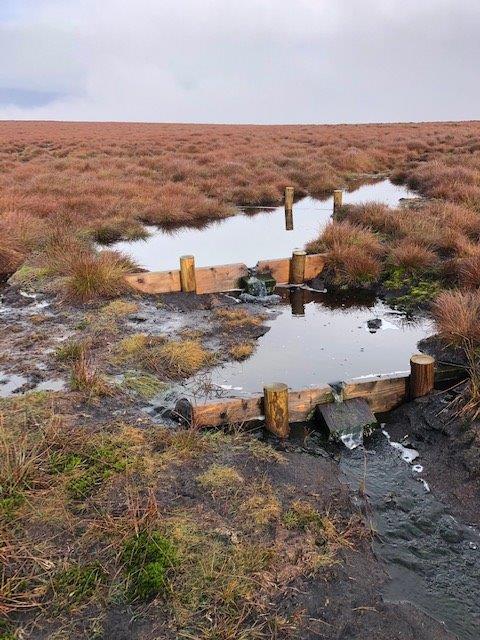Our Changeprint
Our Changeprint can be measured by the area of peatland, grassland and other key habitats restored; visitor benefits (kilometres of footpaths with safer, more sustainable access); level of collaboration and community engagement; and biodiversity and climate benefits (species diversity gains and carbon retained in the peat).
Our story
The Black Mountains Land Use Partnership (BMLUP), established through the Welsh Government's Nature Fund in 2015, provides the driving force behind the restoration and sustainable management of the area's natural resources and habitats. The Black Mountains spread across Powys, Monmouthshire and through the Welsh-English border into Herefordshire, covering 24,600 hectares, with approximately a third of the area being a Site of Special Scientific Interest.
Bringing together key representatives from the area – including farmers, landowners and regulatory bodies such as the Brecon Beacons National Park Authority, Natural Resources Wales, Welsh Water and Natural England - the partnership is a forum for discussion and collaboration on the current and future management, sustainability and conservation of the Black Mountains.
Part of our Sustainable Management Scheme (SMS) project, funded by the Welsh Government and the European Union as part of the Rural Development Programme, has involved an extensive footpath restoration initiative across the group of hills including the Offa's Dyke Path, which had become eroded over time due to high footfall. By lifting slabs of stones to make a pathway to keep visitors on the right track, we are not only protecting the environment but also creating an improved and much safer visitor experience.
Another important strand of our work is managing invasive bracken on the Black Mountains in order to improve the grassland areas, recover plant diversity and allow sheep to graze more effectively. To date, we have increased the usable grazing area by 790 acres.
We are also working hard to reverse the negative decline in dry peat in the area, restoring peat-bog sites to create resilient ecosystems that will help protect carbon in the soil. Our work has seen us safeguard more than 66 hectares of peat land. This has also helped to reduce the release of surface water runoff from the uplands, improving habitat conditions for wildlife and livestock and creating better public access.
The BMLUP promotes safe, sustainable visitation in the Black Mountains as part of a broader education and awareness-raising initiative. Our successful Black Mountains Ambassador Network involves local businesses working with us to share knowledge, skills and experience, and to support safe, sustainable visitation in the Black Mountains. This scheme also helps shape the future of the BMLUP as a truly collaborative, community-based partnership.
We have recently developed a schools programme – taking schoolchildren to the hills to explain the story of hill farming and how it has shaped the landscape they see today. This outdoor learning gives pupils the opportunity to explore the uplands while furthering their education and, most importantly, connecting them to their local landscape.
Our advice
Prior to the formation of the Black Mountains Land Use Partnership (BMLUP), a great deal of division existed between the regulatory bodies and landowners in the area. The Partnership was formed to try to solve this issue and bring about a greater level of collaboration for the common good.
What drove us all were the two key challenges that needed addressing - climate change and nature recovery. We could also foresee that there would be substantial Welsh Government policy change in the future and that it would be difficult for the community to navigate it in isolation. We believed that working together would be very beneficial for the future of the Black Mountains.
Of course, partnership work can be tough - you can't expect to bring large groups of people together and get them all to agree instantly! Even if there are shared goals, there will always be different views on how to reach that goal and, therefore, facilitation - selected by the group - is an important part of this process.
The facilitator can also be responsible for developing and nurturing relationships with the Welsh Government and other key stakeholders - communicating the project's work so that they can learn from it and build successes and failures into policy development.
At the beginning, we spent a great deal of time bringing people together and trying to build trust - good communication is vitally important in partnership work. We would discuss pressing issues, such as climate change, emissions and biodiversity loss, and look at what we could potentially do together to address issues, such as improving biodiversity on the hills. Through open discussion and facilitation, engagement with the wider community has improved significantly throughout the life of the scheme and we are proud of the progress we have made.






